The Chinese money plant (Pilea peperomioides) is an easy plant to propagate with a fascinating history. All you need to know concerning how easy these plants are to breed is a snippet of that history.
A Norwegian missionary named Agnar Espegren took a cutting from a plant in the Yunnan
Province in China (circa 1945), placing it in his luggage. Upon returning to Norway, (via India!), Espegren discovered the cutting was still alive. Planting it, he soon discovered that the primary plant produces offsets, also called pups, which are clones of the original plant. Espergren repotted the offsets, and in his travels as an itinerate missionary, spread Chinese money plants throughout Scandanavia.
Espegren’s occupation is the reason some folks refer to the Chinese money plant as the missionary plant, while his habit of giving plants to friends is what earned Pilea peperomioides the nicknames pass-along plant and friendship plant. The plants’ round leaves are why it is also referred to as the UFO plant and the pancake plant.
Keep reading to learn how to propagate this trending ornamental houseplant.

The plants’ round leaves are why it is also referred to as the UFO plant and the pancake plant.
©Mehta Photography/Shutterstock.com
Chinese Money Plant Propagation: First Steps
Propagation is defined as an action that increases the number of or encourages the spread of an already existing organism. In this case, the organism we wish to grow in number and/or spread is the Chinese money plant.
Propagating Chinese money plants is practically foolproof. Arming oneself with such information should alleviate any anxiety around the process – or should I say processes. That’s right! There’s more than one way to skin a cat, and there’s more than one way to propagate a Chinese money plant!
Depending on the method you use, you’ll need to have a few items at the ready:
- shape, sterile blade
- potting containers
- potting soil
- rooting hormone
- water
Choosing the method of propagation, of course, requires familiarizing oneself with the different ways in which these plants are generated.
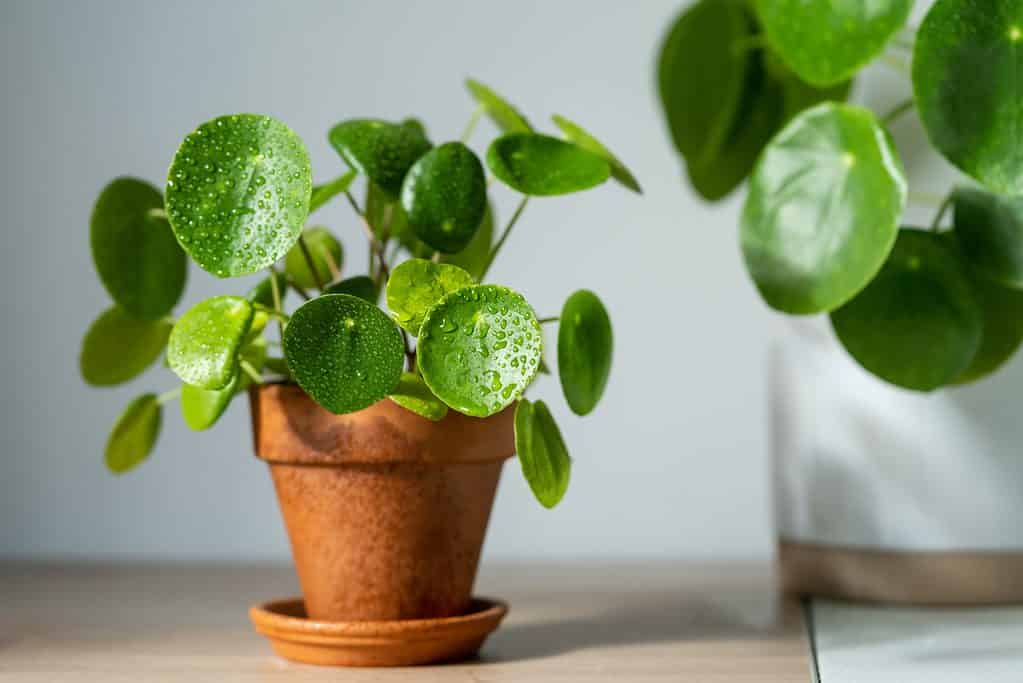
Choosing a method of propagation requires familiarizing oneself with the different ways in which these plants are generated.
©DimaBerlin/Shutterstock.com
Methods of Propagation
Spring is the most opportune time to propagate Chinese money plants. However, growing as houseplants, propagating can occur anytime. Reasons for propagation stem from overcrowding, a desire to have more plants of your own, or, like Mr. Espegren, the desire to pass along the plants as an act of friendship.
Once you notice the mother plant producing offsets, it’s time to start propagating! There are a few distinct methods of propagating this popular ornamental plant, each one a little different than the others, but all with similar results: More Chinese money plants.
Propagation By Division
One method of propagating a Chinese money plant is by division. As its name suggests, propagating by division involves splitting a plant. In the case of Chinese money plants, division is accomplished by removing an offset (or offsets) from the soil around the established plant. This is accomplished in a couple of ways.
One way is to gently work your fingers through and around the offset, loosening it from the soil. The offset will be attached to the original plant by rhizomes and roots. A rhizome is an underground stem that sends out runners from which new plants grow. Rhizomes have slender hair-like roots that keep them anchored in place, but the rhizome itself is what gives life to the plant. If the offset is mature or otherwise well-established, a shape blade might be necessary to separate the rhizome from the parent.
Once the offset and its rhizome have been removed, it can either be placed in a long-necked bottle of water to allow its rhizome to develop before transferring it to a container with soil, or it can be placed directly into soil. Each method has its pros and cons.
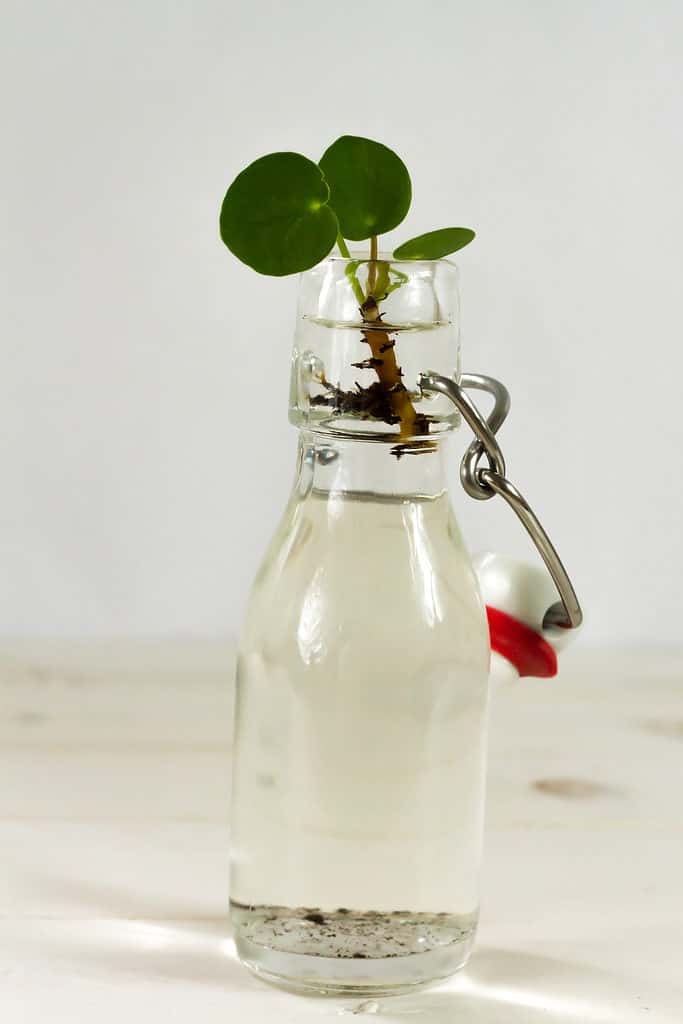
Placing the start in water allows it to develop a more viable rhizome which will require less care once it’s planted.
©Patrycja Nowak/Shutterstock.com
Division in Water
Placing the Chinese money plant start in water allows it to develop a more viable rhizome which will require less care once it’s planted. The rhizome and roots are submerged in the water, while the offset remains above the water. This method ensures success but takes time. Once the plant has developed a stronger rhizome, which will take two to three weeks, when transferred to a pot with soil it should grow well, not needing any extra care.
Offsets can be left rooting in the water indefinitely, but they will not grow as vigorously as those grown in soil.
A Chinese money plant offset immediately transplanted into soil requires a fair amount of attention for several weeks afterward.
Division in Soil
Using this direct soil method, take the offset, placing its rhizome 1-2 inches deep into the soil; larger rhizomes should be planted more deeply than smaller ones. Gently press the soil around the base of the plant to help anchor it.
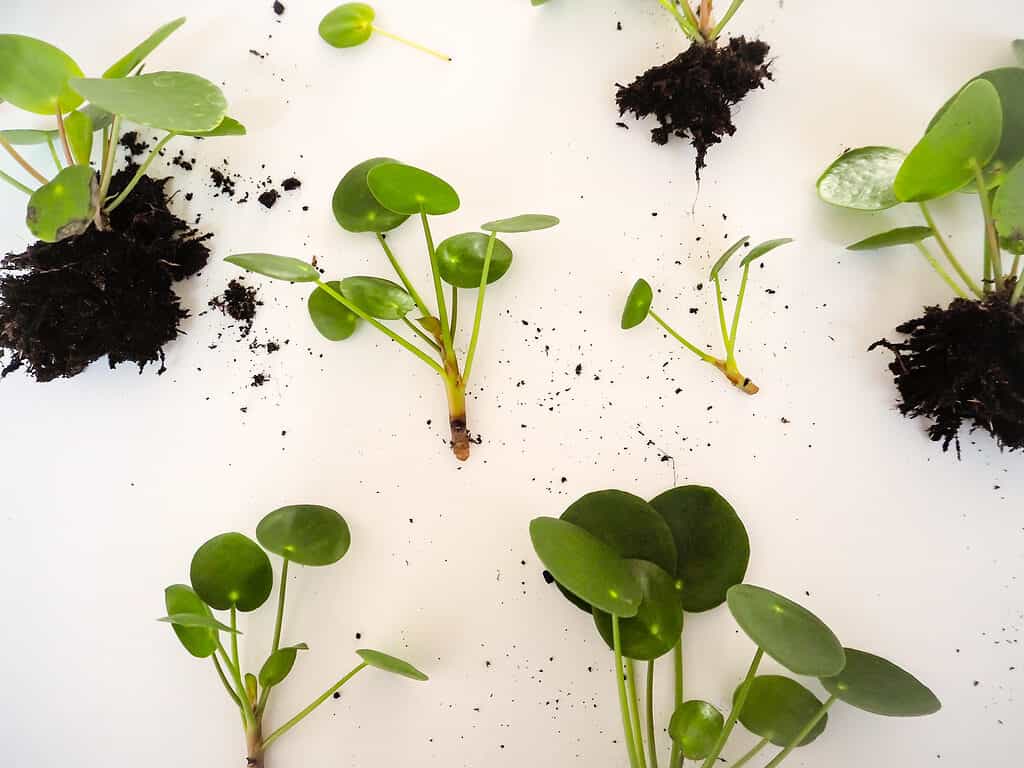
A Chinese money plant offset immediately transplanted into soil.
©Luoxi/Shutterstock.com
Placing the new plant in bright, but indirect light and keeping the soil moist are important at this stage of development. The plant will suffer if the soil is allowed to dry out, as it has not yet developed a large enough rhizome to see it through a drought. After about four weeks, the offset, if its soil has been kept evenly moist, should have developed enough of an underground rhizome to survive a missed watering here and there.
Propagation by Leaf Cutting
Another method of propagation is achieved by taking leaf cuttings from the established Chinese money plant. This action will require a sharp, non-serrated blade. Using the blade, remove one leaf from the plant at the base, making certain to remove a bit of the base of the mother.
Place the cutting in a bottle of water, submerging the stem.
Once the cutting has been placed in water, slender, white roots will begin to appear. In about two weeks an offset should begin to grow from the roots on the submerged stem base. Once the offset appears, the leaf-cutting will begin to die. Such is the circle of life.
Once the roots are about one inch long, the new offset may be transplanted into soil.
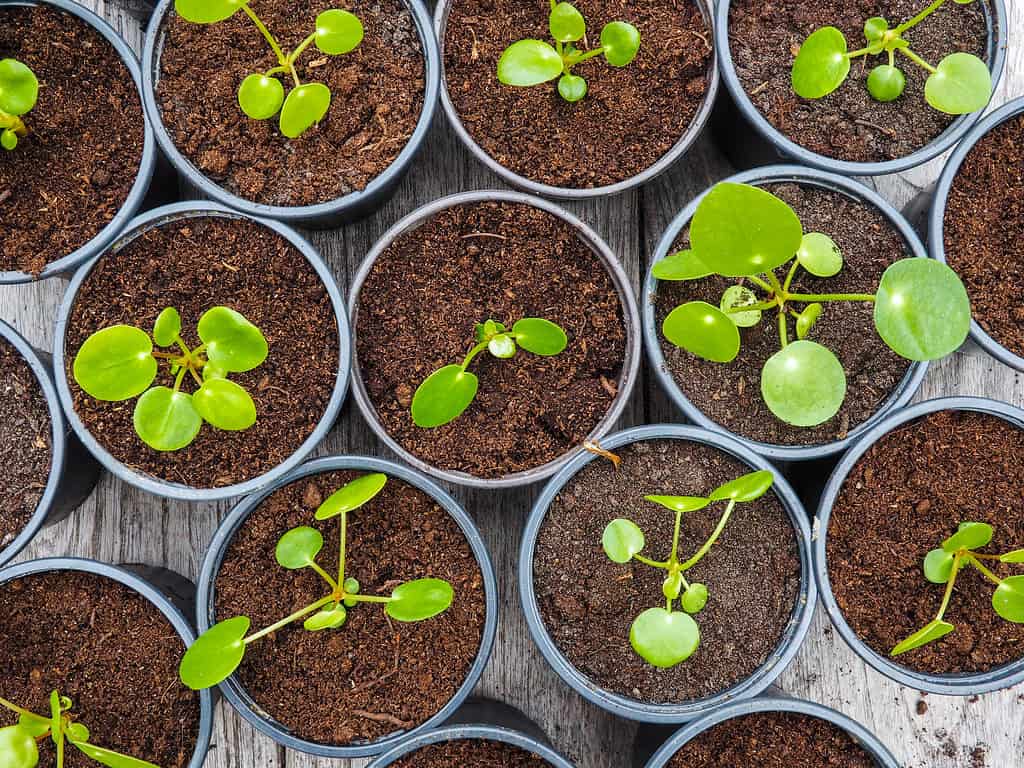
Once the roots are about one inch long, the new offset may be transplanted into soil.
©Luoxi/Shutterstock.com
Leaf cuttings may be transplanted directly into soil when a rooting hormone is used.
Rooting hormones are synthetic chemicals that mimic auxin, a chemical occurring naturally in plants that stimulates root growth. There are several commercial products widely available for this purpose.
Coating the bottom half of the stem with the rooting hormone, place it directly into the soil. As with propagation by division, when placing the cutting directly into the soil, care must be taken so that the soil is not allowed to dry out.
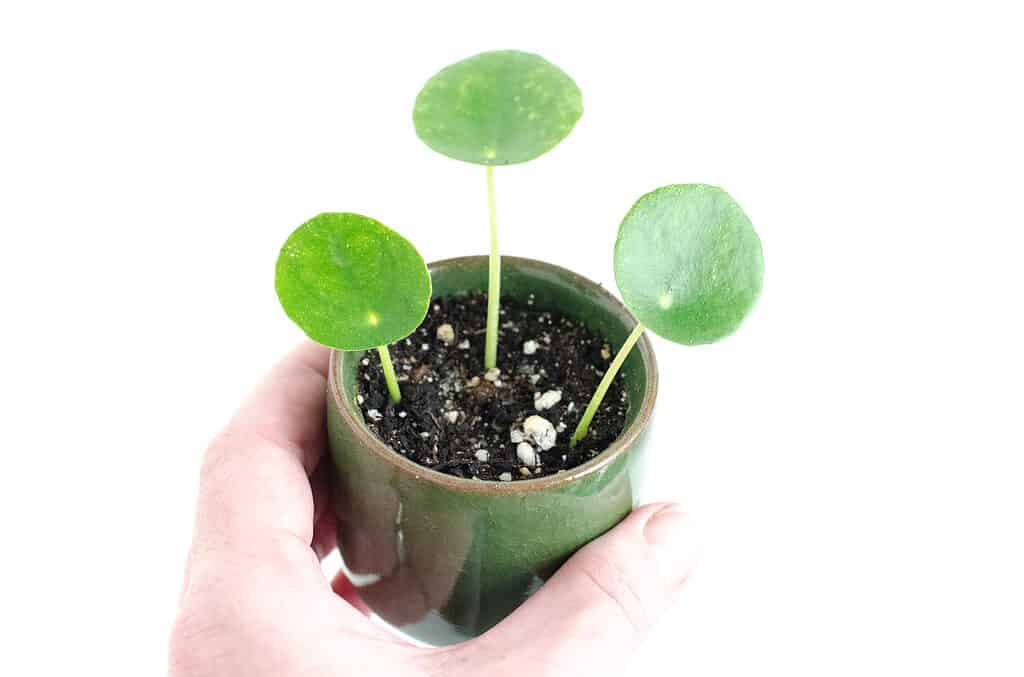
Leaf cuttings may be transplanted directly into soil when a rooting hormone is used.
©Pegasene/Shutterstock.com
Propagation by leaf cuttings is not as reliable as propagation by division. It also takes longer.
Main Stem Propagation
Another method of propagating a Chinese money plant is main stem propagation. Main stem propagation is typically reserved for plants that have grown too large or leggy.
Main stem propagation involves cutting the main plant off at its base. This cutting, as in other types of propagation may be placed in water to encourage root growth, or may be planted directly into soil.
Because the size of the cutting is larger, compared to the offsets of division, the roots will take longer to mature to a satisfactory size to maintain the Chinese money plant.
Allowing the roots to develop in water will take 4-6 weeks, whereas immediately transplanting into soil requires months of vigilance.
Meanwhile, the original plant will be re-growing, though more compactly than before, and producing offsets.
Chinese Money Plant Propagation: Summary
Chinese money plants are straightforward propagators, though the most successful method of those discussed is by division in water. This method is virtually foolproof because Chinese money plants will grow in water. They will not thrive like their counterparts growing in soil, but they will survive. So, if life gets in the way and the opportunity does not present itself to transplant the Chinese money plant in a timely manner, it’s going to survive until the time that it can be transplanted.
Offsets by division placed directly in soil require at least a modicum of diligence regarding their care, principally keeping the soil moist until rhizomes /roots develop and mature.
The least reliable method of propagation of Chinese money plants is through stem cuttings placed directly into the soil. Even applying a rooting hormone is not a guarantee of success. So, if offsets are readily available, propagation by division would seem to be the surest, most direct route to propagating a Chinese money plant. You can read more about Chinese money plants here.
Propagating Chinese money plants is fun. Sharing Chinese money plants with your friends? Priceless.
Up Next:
- Astrological Houseplants: Find Your Perfect Match
- How To Get Rid of Aphids
- The Best Grow Lights For Indoor Plants
The photo featured at the top of this post is © DimaBerlin/Shutterstock.com
Sources
- theteecenter.com, Available here: https://www.thetreecenter.com/the-chinese-money-plant-pass-it-on/
- the spruce.com, Available here: https://www.thespruce.com/growing-pilea-peperomioides-5090425
- pilea.com, Available here: https://www.pilea.com/post/the-real-story-behind-pilea-peperomioides
- savvygardening.com, Available here: https://savvygardening.com/pilea-peperomioides-care/
- abc.net.au, Available here: https://www.abc.net.au/gardening/how-to/propagating-chinese-money-plant/13628524
Thank you for reading! Have some feedback for us? Contact the AZ Animals editorial team.







